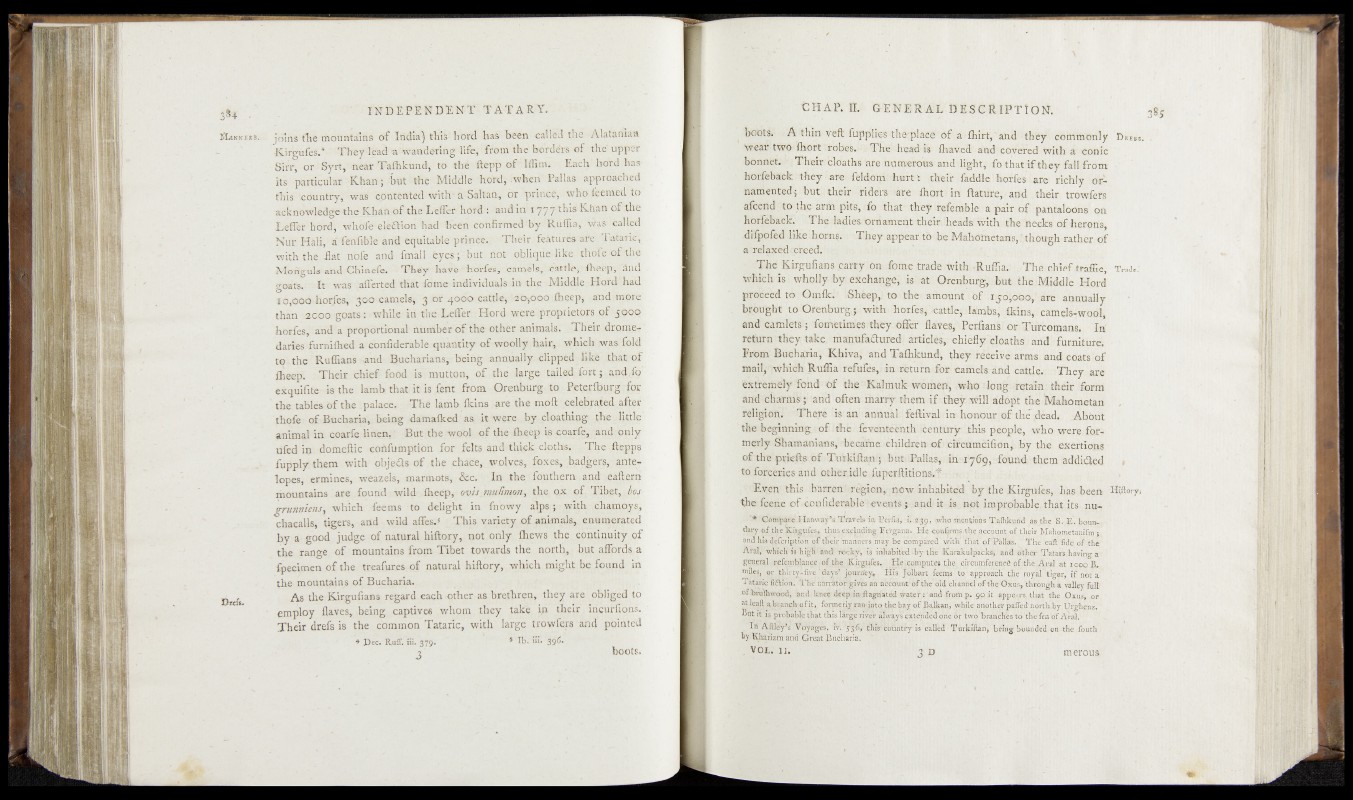
joins the mountains ôf India) this hord has been called the Alatanian
' KiHfes.1 ' iThey l f lt a wanderingihftg; from the borders of the' upper
Siir, or Syrt, near Talhkund, to the ftepp ofTffim. Each' hord has-
-its- particular Khan ; but the Middle hord, .when Pallas approached
this '.country, was contented with' à Saltan, or prince, who deemed to
■acknowledge the Khan of the Lefler- hórd : andin 1777 this Khan of the
Lefler hord, whole election had been confirmed by Ruffia, Wak called
Nur Hâli, a.fenfible and equitable prince. . Their feâturés are Tatarie,
with the Eat nbfe and fmall eyes ; ' but not' oblique like th'ofe ©f the
Môfîgûls and Ghinefe, They have- horfes, camels, cattle, flieepj \ând
goats. It was -arfferted that borne'individuals in <he.. Middles Hof cL had
ïo,ooo horfes, 300 camels, 3 or 4000 cattle, 2<ÿô<^ilheep, and more
than 2coo goats: while in the Leffer Hord were proprietors of 5000
febrfes, - and a proportional number -oCthe other animals. Their drome-r
daries-furnilhed a confiderable quantity of woolly,hair, which was fold
.to. the ' Ruffians -.and Buchariana, being annually clipped likd ,|ha,t. of
£heep. Their, chief* food is“mutton, of the large tailedTöirt; 5 aïuUV
èxquifite is the lamb that it is fent from- Orenburg to Peterfburg for
the tables of the .palace. The lamblkins , are thé moft celebrated afpr
thofe of Bucharia,-being damafked as, itw£re_ by-plof^ing . the. liftlp
animal in coarfe linen. ' But the wool -of the flieep is coarfe, and only
ufed in domeftic confumption for felts and thick cloths.. The ftepps
fupply them with objects of, the chaee, wolves, foxes, badgefs,-antelopes,
ermines, weàzels, marmots, &c. In the fouthern and . eaftern
mountains are found wild flieep, ovis inuUmqji, the o,x of Tibet,
grunniens, which deems to delight in fn'o.wy alps ; with chatnoys,
chacalls, tigers, and wild affes.5 This variety; ofanknals, enumerated
by a good judge of natural hiftory, not only fliews the continuity of
the range of mountains from Tibet towards the north,, but affords.a
fpecimen of the treafures of natural hiftory, which might be found in
the mountains of Bucharia.
As the Kirgufians regard each .other as brethren, they are obliged to
employ flaves, being captives whom they take, in their. incurftons.
Their drefs is the common Tatarie, with large trowfers and pointed
* I?cc. Hi. ' * ’ lb. iii.
3 boots.
betsts.’ A d h in veft' fi^plM^hecplaadf'of' a '-ftiirt/an d they commonly Dress.
wear>t%io/'fh-ort irbbeS»- / The-’head-is thawed" a'nd'CovbFed with a conic
bonnet. T h e it’cldaths afe numerous and light, fo that if th ey fall from
horfeback they are- feldomlfhum i t e r laddie:horfes ,are richly or-
but. their ridehsA-are Ih o rt1 In ftattire, arid their trowfers
afcend'to the arm pits, To #thar they referable a p a ir o f pantaloons on
horfeback. The ladies.-Ornament .their, heads with th e hecks o f herons,
difpofed like horns. Th ey appear to be Mahometans,/thewgh rather o f -
a relaxedrerced. ‘ >..
Thé Eirgufiao'S f arty önufome -trade w ith .-Ruff a. The ,chief traffic, Trade.'
which is 'w h o lly by, exchanger is' a t O renburg,/but the f i d d l e -Hord
proceed tb OmfkA iShéep,; to'the.- amount' 1 h f- i r^diofes^a re annually
brought touQfenburgc with TolfeaLteaMle,' Jafcnbs; {kins,-Tamils-; wool,
énd Cam%i} 'fomfediafeïïhëy Offer flashes,/Perfians or: Turcomans.. ‘In'
re tu rn n h è y take, manufactured anticlès,, chiefly-cl oaths; and furniture.
Erom Bueharia, Rhiva^ and Talhkund, they receive afms and. coats of
mail, .which Ruffia refafes,j an.return for camels, and cattle;.' They are
€‘&tf èmëly fo n d -Öf thp-Kalmuk -w®*ö'ë$ w-h© j long, - retaxn. their form
and ©h airntö ;>?and often iharry -them . i f -they. Will ;atópt the Mafeo metan ,
religion. HShejpé 'is an:» anhukl. feftivab in-honour, of' tbie'dèad. About
tfebegtnui^iofiiriife fev-entéënlh tepatury this people, who Ware Tot?
nTterly Mia'iAariia'ns, 'becaime chjldren©K;eftéümciGünf by the- .ekemefes -
of "the prieftsvof Turkiftani;. but; Pallas, in 1769, ■ founds them addifted
to forebries and other idle fuperftitions.f • ,
Even this barren' region,- now inhabited by the Kirgufes, has been Hiftory.-
fhéTceiie offc-onfiderablè : eye.nts; and it isL.-hpt improbable that its nu-
*■ Berfia, riii^p^wWijtnBti<>$s Tafhjs-apd ay die S^E; Jjomw
ty e f of t h eKit gufes, •'
and lus^sfcrigtion of their ‘manners may be- compared with’ fhal öï^PaHas; ’ The 'eait iide df-'the
Aral, wfiicii'is hi^ll'fand rocky, is inhabited i'by the iCarakulpacks-, and' ather ‘Tatars having a '
general nefembVinoe.ofjh^Kirgufes, ^ejcpirputes the> aircumferenpï hftthe.Aral at igioi B.
mues, éi- thlityi-foe'days’ jourrifcy, His Jolbart feems to ■ apprpach' the royal tiger, if-riot a •
Tataric ffiftfoS. ’Th'b iïarVa'tpr;^ivés Sn aéétfuntJ6 Ïth r old chanhél of ( ' | Cthibugh a valley full
,t)f-brufhwobd, .and:knee .dlspfin.!ftagriated water :'anil from p. ..goiït appears, that the Oxus, or ‘
ithl-anphqf it, foraerljf ran: into -.the bay of Balkan» ^|lc^|ptherpa'iTed’nórth,l^Hrgheüz,'
Bi)t it is probatte that ffis. large river always' extendedone or two brandfies to tlre'fe^'iif Aral.
Ui Aftley’s Voyages, iv. '536, Jfiis* country is ' called Tnrkiftan, being bounded on the fouth
hy.'lihMam and Great .Bucharia.
VOL. h. .3 Ö merous.